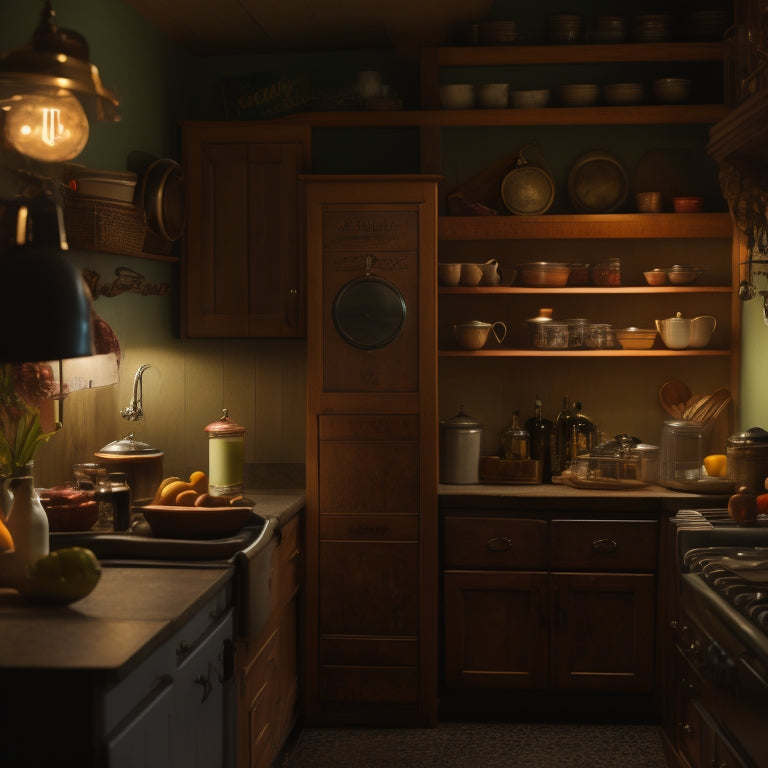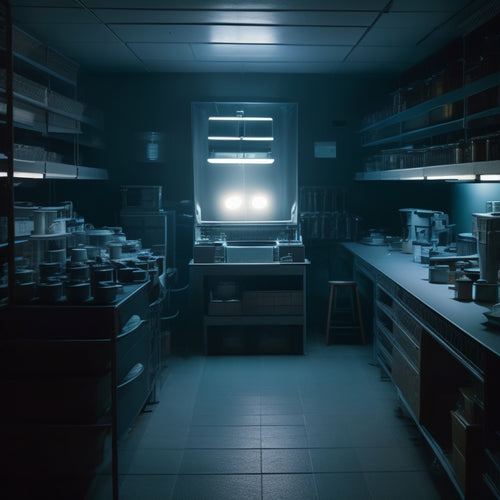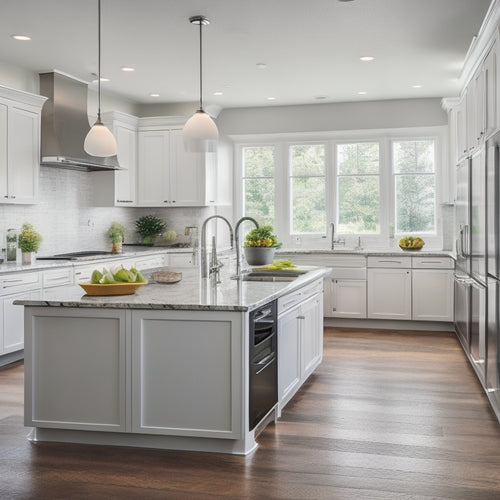
What's Hiding in Your Kitchen Cabinets?
Share
You're likely storing at least a dozen expired or nearly expired food items, unknown stains, and overlooked kitchen gadgets in your cabinets, which are not only wasting your money but also posing health risks and creating clutter. Expired goods, inefficient cabinet configurations, and a "out of sight, out of mind" mentality contribute to the mess. Toxic containers, paperwork piles, and hidden hazards are also lurking in the shadows, waiting to be uncovered. As you open those cabinet doors, you'll discover a world of forgotten items and potential safety risks - and that's just the beginning of what's hiding in your kitchen.
Key Takeaways
• Forgotten food and expired goods may be lurking in your kitchen cabinets, leading to food waste and unnecessary expenses.
• Inefficient cabinet configurations and poor cabinet customs contribute to clutter and disorganization.
• A pantry audit is essential to uncover hidden culprits, remove and categorize items, and discard expired goods.
• Hidden contaminants like mystery stains and unseen grime can accumulate in kitchen cabinets, posing health risks.
• Toxic food storage containers and expired or spoiled food can leach harmful chemicals into food, leading to health hazards.
Common Cabinet Clutter Culprits
At least a dozen expired or nearly expired food items are likely lurking in your kitchen cabinets, taking up valuable space and posing potential health risks. These common cabinet clutter culprits can be attributed to inefficient Cabinet Configurations and poor Cabinet Customs.
Perhaps you've fallen victim to the 'out of sight, out of mind' mentality, where you stash food items in hard-to-reach areas or behind other items, making them prone to expiration. Or, you might be guilty of buying in bulk without a clear plan for consumption, leading to a buildup of expired goods.
Whatever the reason, it's crucial to acknowledge these habits and make a conscious effort to change them. Start by reassessing your Cabinet Configurations to make sure they're optimized for visibility and accessibility. Then, establish Cabinet Customs that promote regular inventory checks and mindful shopping habits.
Forgotten Food and Expired Goods
Your kitchen cabinets likely harbor a stash of forgotten food and expired goods, silently accumulating dust and posing a threat to your health and wallet.
It's easy to overlook the cans and packets hiding in the back of your shelves, but they can lead to food waste and unnecessary expenses.
A pantry audit is essential to uncover the hidden culprits and take control of your kitchen.
Start by removing everything from your cabinets and sorting items into categories. Check expiration dates and toss anything that's past its prime.
Be ruthless - if you haven't used it in the past year, it's likely you won't miss it.
You'll be surprised at how much food waste you can eliminate by simply being more mindful of your inventory.
Kitchen Gadgets Taking Over
Cluttered countertops and overflowing drawers reveal a common kitchen conundrum: an accumulation of gadgets that promised to revolutionize cooking but now gather dust. You're not alone in this struggle. Many of us have fallen victim to Gadget Overload, buying into the promise of ease and efficiency only to find ourselves overwhelmed by the sheer number of devices vying for space.
It's time to take back control of your kitchen. Start by assessing your gadgets – which ones do you use regularly, and which ones have been relegated to the back of the cabinet? Be honest with yourself; if you haven't used it in the past year, it's probably safe to let it go. Invest in Space Savers like stackable containers and adjustable dividers to maximize your storage capacity.
Mystery Stains and Unseen Grime
Behind the tidy facade of your kitchen cabinets, mystery stains and unseen grime lurk, silently accumulating on shelves, in corners, and along the edges of containers. You mightn't notice them at first, but these hidden contaminants can harbor bacteria, odors, and pests, compromising the cleanliness and organization of your kitchen. Surface cleaners can help eliminate visible stains, but they often leave behind residues that attract dirt and dust, creating an environment conducive to further grime buildup.
To truly tackle the mystery stains and unseen grime, you need to dig deeper. Start by removing everything from your cabinets and inspecting each item carefully. Check for expiration dates, signs of spoilage, and hidden moisture spots.
Wipe down containers and shelves with a gentle yet effective cleaner, making sure to reach into tight spaces and corners. Don't forget to clean the cabinet doors, handles, and hinges, as these areas can harbor hidden grime and fingerprints.
Overwhelming Pile of Papers
Now that you've tackled the grime and stains, it's time to turn your attention to the overwhelming pile of papers cluttering your kitchen countertops.
You're likely aware that this chaotic mess is more than just an eyesore - it's also a potential breeding ground for missed deadlines and forgotten tasks.
As you start to sort through the papers, you'll need to prioritize what's truly important to avoid further disorganization and stress.
Cluttered Countertop Chaos
Your kitchen countertop, once a hub of culinary activity, has devolved into a chaotic landscape dominated by a towering pile of papers, threatening to engulf your productivity and sense of control.
This cluttered countertop chaos isn't just an eyesore, but also a reflection of your inner state. According to countertop psychology, a cluttered space can lead to feelings of anxiety, overwhelm, and disorganization.
As you start your morning routine, this overwhelming pile of papers greets you, setting the tone for the rest of your day. It's hard to begin with a clear mind when surrounded by bills, receipts, and reminders.
The clutter seems to seep into your mental space, making it difficult to prioritize tasks and focus on what's important. By acknowledging the emotional impact of this clutter, you can take the first step towards reclaiming your kitchen countertop and, ultimately, your sense of control.
It's time to confront the chaos and create a more harmonious space that nurtures your well-being and productivity.
Papers to Prioritize Now
Among the towering pile of papers, you'll likely find a mix of essential documents, redundant receipts, and forgotten reminders, all vying for your attention. To regain control, start by separating the papers into categories: bills to pay, documents to file, and items to toss. Focus on the most critical documents, such as insurance policies, identification, and financial records. These should be stored in a secure, easily accessible location.
Next, tackle your bill management by organizing invoices and payment due dates. Consider implementing a document organization system, like a file folder or digital tool, to keep track of your papers. Be ruthless when it comes to getting rid of unnecessary documents – recycle or shred anything that's outdated or irrelevant.
Missed Important Deadlines
Failing to stay on top of paperwork can lead to missed deadlines, late fees, and even penalties, ultimately causing more harm to your finances and reputation than the cluttered kitchen cabinet itself. You're not alone in this struggle, but it's time to take control.
When you let paperwork pile up, you risk overlooking critical deadlines, and the consequences can be severe.
Effective time management is key to avoiding these pitfalls. Start by designating a specific time each day or week to tackle your paperwork. Break down larger tasks into smaller, manageable chunks, and prioritize them based on urgency. This will help you stay focused and avoid procrastination.
Procrastination strategies, such as the Pomodoro Technique, can also be helpful in staying on track. By implementing these strategies, you'll be able to stay on top of your paperwork, meet deadlines, and avoid costly mistakes.
Dusty Decorations and Knick-Knacks
Dusty decorations and knick-knacks sitting on your kitchen shelves or tucked away in cabinets are a haven for dust, dirt, and allergens. These seemingly harmless items can harbor unwanted particles that can aggravate respiratory issues and trigger allergic reactions. Take a closer look at the decorative items you've accumulated over the years and ask yourself: do they bring you joy or are they just collecting dust?
| Decoration Type | Dust Accumulation Risk |
| Collectible trinkets | High |
| Seasonal ornaments | Medium |
| Ceramic figurines | Low |
It's time to reassess the items you've been holding onto. Consider dusting or replacing those collectible trinkets that have lost their luster. Store seasonal ornaments in airtight containers to keep them clean and dust-free. By decluttering and cleaning your kitchen decorations, you'll create a healthier and more welcoming space for you and your loved ones.
Hidden Hazards and Safety Risks
When you open your kitchen cabinets, you're likely to find more than just old spices and forgotten cookbooks. You might uncover hidden hazards and safety risks that can put your health and well-being at risk.
From toxic food storage containers to expired food risks and hidden fire hazards, identifying and addressing these potential dangers lurking in your kitchen is crucial.
Toxic Food Storage
Your kitchen cabinets may be harboring a hidden threat to your health and wellbeing: toxic food storage containers that could be leaching harmful chemicals into your meals. Chemical leaching, a process where chemicals migrate from plastics into food, is a significant concern. This can occur when you store food in low-quality plastic containers, especially when they come into contact with fatty or acidic foods.
Plastic migration, where plastic particles break down and enter your food, is another risk. Toxic chemicals like BPA, phthalates, and PFAS can seep into your food, potentially causing health issues. These chemicals have been linked to various health problems, including cancer, hormonal imbalances, and reproductive issues.
It's essential to be aware of the materials used in your food storage containers. Look for containers made from non-toxic materials like glass, stainless steel, or BPA-free plastic. Avoid using old or worn-out containers, as they're more likely to leach chemicals. By making informed choices about your food storage, you can reduce your exposure to these harmful chemicals and create a safer, healthier kitchen environment.
Expired Food Risks
Many kitchen cabinets harbor expired or spoiled food, which can pose significant health risks to you and your family, from foodborne illnesses to allergic reactions.
When you consume expired or spoiled food, you're putting yourself at risk of food poisoning. According to the Centers for Disease Control and Prevention (CDC), food poisoning affects one in six Americans annually, resulting in approximately 128,000 hospitalizations and 3,000 deaths.
Regularly check your kitchen cabinets to make sure that you're not storing expired or spoiled food. Pay attention to the 'Use By' or 'Best If Used By' dates on packaged foods, as these indicate the shelf life. Don't rely on appearance or smell alone, as expired or spoiled food can look and smell fine.
Instead, trust the expiration dates and use your best judgment. Remember, it's always better to err on the side of caution when it comes to your health.
Hidden Fire Hazards
Kitchen cabinets can conceal hidden fire hazards in the form of faulty or outdated electrical appliances, worn-out cords, and flammable materials, which can spark a devastating blaze if left unchecked. You might think your kitchen is safe, but take a closer look. Are you using faulty appliances or overcrowding outlets, risking electrical overload? It's important to identify and address these hazards to make sure your kitchen remains a safe haven.
Regularly inspect your appliances, cords, and cabinets for signs of wear and tear. Check for frayed cords, broken plugs, and overheating devices. Replace them immediately if you notice any damage.
Additionally, avoid overloading outlets with multiple plugs, as this can cause electrical fires. Keep flammable materials, such as curtains, towels, and cooking utensils, away from heat sources like stovetops and ovens.
Disorganized Spices and Seasonings
Spices and seasonings, often the most frequently used items in cooking, tend to accumulate in a jumbled mess at the back of your cabinet shelves. It's easy to let them pile up, but disorganization can lead to flavorless dishes and wasted time searching for the right spice. Take control of your spice collection by implementing a simple organizational system.
| Spice Rack Solution | Benefits |
|---|---|
| Alphabetize spices | Easily find the spice you need |
| Group spices by flavor profiles | Create harmonious flavor combinations |
| Store spices in airtight containers | Preserve flavor and aroma |
Unused or Broken Items
Cluttered shelves and countertops often conceal unused or broken items, silently taking up valuable space in your kitchen cabinets. It's time to confront the reality: these items aren't only taking up physical space but also mental energy. You might be holding onto them because you think you'll use them someday or because they hold sentimental value.
Here are 4 common culprits to look out for:
-
Broken appliances: That blender that hasn't worked in years or the toaster with the faulty heating coil - it's time to let them go.
-
Forgotten treasures: The cookware you got as a gift but never used, the special occasion dishes that only see the light of day once a year.
-
Duplicate items: Do you really need three garlic presses or four wooden spoons?
- Outdated gadgets: The egg slicer or the avocado peeler that was trendy a few years ago but now collects dust.
Frequently Asked Questions
How Often Should I Clean My Kitchen Cabinets?
You should clean your kitchen cabinets every 1-2 months to maintain cabinet organization, and consider a seasonal refresh to declutter and revamp your storage, ensuring a tidy and inviting cooking space that feels like home.
Can I Use Expired Food if It Looks and Smells Fine?
You're tempted to use expired food that looks and smells fine, but don't risk it! Food safety experts stress that even if it appears okay, expired food can harbor bacteria, compromising shelf life and your health.
Are Kitchen Gadgets Worth the Storage Space They Take Up?
You decide if kitchen gadgets are worth the storage space by considering your cooking frequency and needs. Implementing Gadget Organization and Space Efficiency strategies helps you optimize storage and make the most of your kitchen's real estate.
How Can I Remove Stubborn Stains From Cabinet Shelves?
"Like a master detective, you're hot on the trail of those pesky stains. Remove them by mixing baking soda and water, then applying it to the stained area. Finally, cover with shelf liners and consider cabinet refacing for a fresh start."
Should I Keep Recipes and Cooking Instructions in My Kitchen Cabinets?
You're wise to contemplate storing recipes and cooking instructions in your kitchen cabinets, as it can help with recipe organization and reduce kitchen clutter, keeping your cooking space tidy and efficient.
Related Posts
-

Mastering the Art of Darkroom Photography
You're about to enter a precise, hands-on world where you'll enhance your photographic vision into museum-quality pri...
-

5 U-Shaped Kitchen Layout Ideas to Revamp Your Space
You're about to reveal the secret to a kitchen that's both stunning and supremely functional, where every inch of spa...

